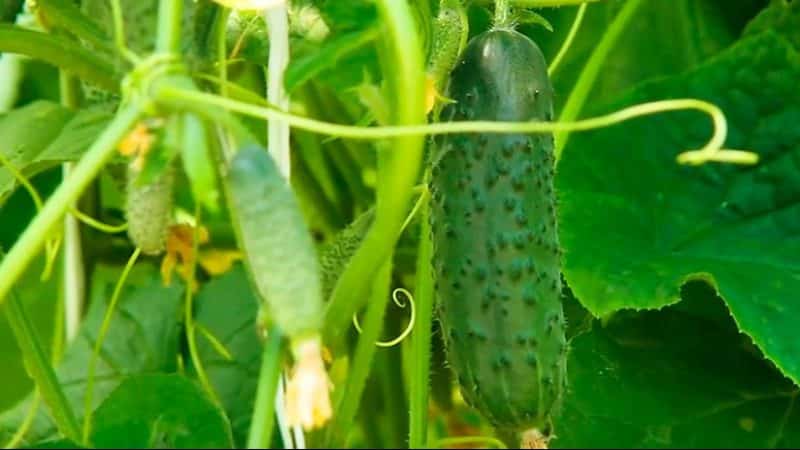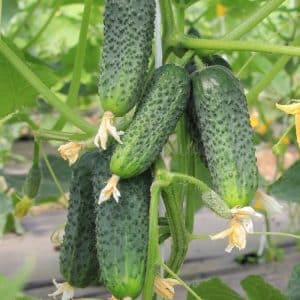Consistently productive and time-tested cucumber “Mother-in-law”
Cucumber Mother-in-law is an early-ripening hybrid. Designed for film and greenhouse cultivation and, like a real mother-in-law, survives in any weather: heat, showers and dew. Resistant to fungal diseases. We will talk about these and other advantages of Mother-in-law cucumbers in the article.
Mother-in-law cucumbers: detailed description
The Mother-in-law cucumber is a hybrid: the packaging with seeds has a confirmation marking F1. It belongs to the achievements of domestic selection: bred on the basis of the Gavrish agricultural company together with scientists from the Moscow Research Institute of Vegetable Growing.
Reference! Cucumber Mother-in-law F1 is recommended for cultivation in central and central Russia. Cultivation in the Siberian and Far Eastern districts is undesirable due to the risk of a significant reduction in yield.
Distinctive features
This is an early-ripening parthenocarpic hybrid: greens ripen within 45-50 days after germination, and the participation of insects is not required for fertilization. Farmers are attracted by the hybrid’s unpretentiousness, high yield and resistance to many vegetable diseases. The culture is immune to powdery mildew and peronospora.
Composition, properties, benefits, calorie content

Cucumber Mother-in-law F1, like its brothers, consists of 95% structured water. There are other elements in the composition:
- beta-carotene;
- vitamins of all groups;
- minerals;
- cellulose.
Fresh cucumbers have a number of beneficial properties for the body: improving intestinal function, a beneficial effect on the thyroid gland, preventing the formation of cholesterol plaques, and a general tonic effect. This is one of the lowest-calorie products - 100 g of vegetable contains only 15 kcal.
Other characteristics
| Part | Description |
| Bush | A powerful plant with large dark green leaves, an average level of branching, indeterminate (tall) bushes, up to three ovaries in each axil. |
| Fruit | Dark green color, faintly traced whitish stripes, regular cylindrical shape, small spines and pimples present. Length – 11-13 cm, weight – 100-150 g, small seeds. |
| Taste qualities | The pulp is dense, homogeneous, juicy, there are no voids, there is no bitterness. |
| Productivity | The maximum yield from one bush is up to 7 kg. Productivity per 1 sq. m – up to 12 kg. |
How to raise Mother-in-law on your own
The growing technology is classic: preliminary selection and preparation of a site, growing seedlings or planting seeds in the ground. Below is step-by-step care for the sprout: watering, feeding, bush formation.
Planting by seeds and seedlings
It is preferable to grow cucumbers Mother-in-law F1 in seedlings. The landing procedure begins at the end of April. To do this, the seeds are placed in separate containers: cups, peat tablets. Then they spill the soil, cover the containers with film, and transfer them to heat (+20-24°C). Optimal indoor humidity is 60-80%. Hybrid Mother-in-law F1 needs long-term lighting, at least 12 hours.
After the appearance of cotyledon sprouts, the temperature is reduced by 2-3 degrees. Water the seedlings daily with water at room temperature.Planted in a permanent place after the formation of 2-3 full-fledged leaves.
Transplanted according to the algorithm:
- Spill the container generously.
- Turn the container over along with a lump of earth.
- Lower the sprout with soil into the prepared hole. The optimal depth is 1-2 cm.
Cucumbers are planted in open ground no earlier than May. In the first ten days of May, the seedlings are covered with film at night.
Growing in stages and care
After transplanting the sprouts to a permanent place, the plant is given time to adapt: 10-12 hours. During this period, it is not recommended to touch the seedlings. A day after planting, the sprouts are watered with settled water. Further watering carried out daily; on particularly hot days, the bushes are watered twice a day. After the ovaries form, watering is reduced to once every 2-3 days. It is advisable to use water heated in the sun.
The next component of care is the application of fertilizing. The procedure begins 4-6 days after planting the sprouts in open ground (when there are 3-4 pairs of leaves on the bush). Suitable choices are a mixture of mullein and water (1:10) or a mixture of chicken manure and water (1:20). Pour the solution strictly at the root.
Other variations of fertilizing for cucumber bushes:
- Herbal infusion. Any weed with a succulent stem will do. Pour boiling water over and leave to ferment for 7-10 days. Dilute the resulting mixture with water in a ratio of 1:5.
- Yeast help. Dissolve dry yeast (1 sachet) in 3 liters of warm water. Sweeten the mixture, add 2 tsp. Sahara. Beat until foam appears. Then add 10 liters of water and spill the soil under the bushes.
- Application of special complex fertilizers. These are “Gumi-Omi”, “BioHumus”, “Bogatyr”.
A mandatory procedure when growing Mother-in-law F1 cucumbers is the formation of bushes and tying up vines.The hybrid grows in one stem, so it is recommended to remove the mustache and stepsons in a timely manner. Long cucumber vines must be lifted and tied to trellises.
Features of cultivation and possible difficulties
Weak growth and pale color of leaves - such problems are caused by the fact that the cultivation technology is not followed. The culture loves moisture, but does not tolerate its excess. Mother-in-law F1 cucumbers do not like drafts and blown areas.
Attention! As the cucumber bush grows, fruiting goes up. The lower old leaves are removed in a timely manner so that dirt, moisture and harmful fungi do not accumulate on them.
Diseases and pests
Overview table of typical diseases of the hybrid Mother-in-law F1.
| Name | Specifics | Control measures |
| Alternaria or dry spotting | Affects greenhouse plants.
The main symptom is raised brown spots on the leaves. |
Spraying bushes with “Bravo”, “Quadris”, “Poliram” preparations. Bordeaux mixture (1%) is also suitable. |
| Mosaic | Appears after sudden temperature changes. Accompanied by yellowing and deformation of leaves, poor flowering, lack of new ovaries and falling of old ones. | Removal of infected bushes, spraying with Farmayod-3 solution. |
| Cladosporiosis or olive spot | The disease can be recognized by the drying edge of the leaf. Ulcers appear on the stems, and the fruits become covered with brown potholes. | Stop irrigation for seven days. Treatment with Bordeaux mixture or Oxyx. |
Overview table of possible pests of cucumber Mother-in-law F1.
| Name | What does it look like | How to fight |
| cucumber mosquito | Insect, body length – 4 mm. Dark gray color, with brown or red tints present. |
|
| Spider mite | Small brown individuals. Body length – 0.5 cm, 4 pairs of legs. | Destruction of the affected parts of the plant.
Treatment with folk remedies (diluted peroxide or ammonia, infusion of dope, onion and garlic). Use of biological products “Fitoverm”, “Kleschevit”, “Akarin” and analogues.
|
| Sprout fly | Front sight up to 5 mm long. It has a hairy body, large eyes, and antennae on its forehead. | Treatment of bushes with insecticides “Fufanon”, “Kemifos”, “Iskra”. |
| Bakhchevaya aphid | A sucking yellowish insect, body size – 2-3 mm. | Treating a greenhouse or hotbed with Karbafos, spraying bushes with Iskra and Confidor. |
| Slugs | Elongated small mollusks. | Treating beds with iron or copper sulfate, using poisons - “Meta”, “Slug Eater”, “Thunderstorm”. |
Harvesting and application
Mother-in-law F1 is distinguished by a gradual return of the harvest - the stated 6-7 kg are obtained from the bush not in 1-2 times, but over the entire season. Greens are picked daily or every two days. Fresh cucumbers will last in a cold place for up to 5-7 days. They are eaten fresh, prepared into salads, pickled, and lightly salted. Cucumbers are also frozen whole, and in winter they are grated or chopped to prepare aromatic okroshka or vitamin salad.
Advantages and disadvantages
Mother-in-law F1 cucumbers are drought-resistant and are grown almost all over Russia. Also among the advantages are high yields and gradual, rather than massive, yield of the crop.
The variety has no obvious disadvantages. Among the relative disadvantages, the high cost of seeds is noted.
Reviews from gardeners
The following is an overview of the opinions of amateur farmers about Mother-in-law F1 cucumbers.
Gennady, Voronezh: «We spent a long time looking for cucumbers suitable for our greenhouse. We tried several, but chose the Mother-in-law F1.Simultaneous emergence of seedlings, rapid adaptation to greenhouse conditions, early ripening and good transportation are the main reasons that today we plant only Mother-in-Law F1.”
Victoria, Cherepovets: “The hybrid attracts me with its unpretentiousness and productivity. It’s not a hassle to care for, but we make sure to tie up the bushes (this makes it easier to harvest). Over 3 years of cultivation, a single aphid attack is the only problem.”
Svetlana, Krasnodar: “We planted Mother-in-law F1 last spring. The season was unsuccessful: rains, temperature changes, cold. But the chosen hybrid withstood all the difficulties perfectly and pleased us with a good harvest. There were enough greens for both food and pickling, although we only planted 15 bushes.”
Conclusion
Cucumber Mother-in-law F1 is an early-ripening parthenocarpic and indeterminate hybrid of Russian selection. The bush is powerful, the branching is average, the green foliage is dark green with pimples and thorns. The hybrid is distinguished by its ease of care and the versatility of using the fruits: eaten fresh, pickled, pickled, frozen. The rules of cultivation and care are standard - abundant watering, tying and forming a bush, regular fertilizing.